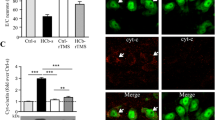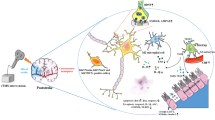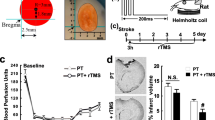Abstract
Repetitive transcranial magnetic stimulation (rTMS) has been studied increasingly in recent years to determine whether it has a therapeutic benefit on recovery after stroke. However, the underlying mechanisms of rTMS in stroke recovery remain unclear. Here, we evaluated the effect of rTMS on functional recovery and its underlying mechanism by assessing proteins associated with neural plasticity and anti-apoptosis in the peri-lesional area using a subacute cerebral ischemic rat model. Twenty cerebral ischemic rats were randomly assigned to the rTMS or the sham group at post-op day 4. A total of 3,500 impulses with 10 Hz frequency were applied to ipsilesional cortex over a 2-week period. Functional outcome was measured before (post-op day 4) and after rTMS (post-op day 18). The rTMS group showed more functional improvement on the beam balance test and had stronger Bcl-2 and weaker Bax expression on immunohistochemistry compared with the sham group. The expression of NMDA and MAP-2 showed no significant difference between the two groups. These results suggest that rTMS in subacute cerebral ischemia has a therapeutic effect on functional recovery and is associated with an anti-apoptotic mechanism in the peri-ischemic area rather than with neural plasticity.





Similar content being viewed by others
References
Abas F, Alkan T, Goren B, Taskapilioglu O, Sarandol E, Tolunay S (2010) Neuroprotective effects of postconditioning on lipid peroxidation and apoptosis after focal cerebral ischemia/reperfusion injury in rats. Turk Neurosurg 20:1–8
Antonsson B (2001) Bax and other pro-apoptotic Bcl-2 family “killer-proteins” and their victim the mitochondrion. Cell Tissue Res 306:347–361
Baird AE, Benfield A, Schlaug G, Siewert B, Lovblad KO, Edelman RR, Warach S (1997) Enlargement of human cerebral ischemic lesion volumes measured by diffusion-weighted magnetic resonance imaging. Ann Neurol 41:581–589
Bury SD, Eichhorn AC, Kotzer CM, Jones TA (2000) Reactive astrocytic responses to denervation in the motor cortex of adult rats are sensitive to manipulations of behavioral experience. Neuropharmacology 39:743–755
Charriaut-Marlangue C, Margaill I, Represa A, Popovici T, Plotkine M, Ben-Ari Y (1996) Apoptosis and necrosis after reversible focal ischemia: an in situ DNA fragmentation analysis. J Cereb Blood Flow Metab 16:186–194
Clemens JA, Stephenson DT, Smalstig EB, Dixon EP, Little SP (1997) Global ischemia activates nuclear factor-kappa B in forebrain neurons of rats. Stroke 28:1073–1080 discussion 1080–1071
Darby DG, Barber PA, Gerraty RP et al (1999) Pathophysiological topography of acute ischemia by combined diffusion-weighted and perfusion MRI. Stroke 30:2043–2052
Fitzgerald PB, Brown TL, Daskalakis ZJ, Chen R, Kulkarni J (2002) Intensity-dependent effects of 1 Hz rTMS on human corticospinal excitability. Clin Neurophysiol 113:1136–1141
Fujiki M, Kobayashi H, Abe T, Kamida T (2003) Repetitive transcranial magnetic stimulation for protection against delayed neuronal death induced by transient ischemia. J Neurosurg 99:1063–1069
Gao F, Wang S, Guo Y et al (2010) Protective effects of repetitive transcranial magnetic stimulation in a rat model of transient cerebral ischaemia: a microPET study. Eur J Nucl Med Mol Imaging 37:954–961
Garcia JH, Wagner S, Liu KF, Hu XJ (1995) Neurological deficit and extent of neuronal necrosis attributable to middle cerebral artery occlusion in rats. Statistical validation. Stroke 26:627–634 discussion 635
Hausmann A, Weis C, Marksteiner J, Hinterhuber H, Humpel C (2000) Chronic repetitive transcranial magnetic stimulation enhances c-fos in the parietal cortex and hippocampus. Brain Res Mol Brain Res 76:355–362
Heiss WD, Huber M, Fink GR, Herholz K, Pietrzyk U, Wagner R, Wienhard K (1992) Progressive derangement of periinfarct viable tissue in ischemic stroke. J Cereb Blood Flow Metab 12:193–203
Hu XL, Olsson T, Johansson IM, Brannstrom T, Wester P (2004) Dynamic changes of the anti- and pro-apoptotic proteins Bcl-w, Bcl-2, and Bax with Smac/Diablo mitochondrial release after photothrombotic ring stroke in rats. Eur J Neurosci 20:1177–1188
Ivanco TL, Greenough WT (2000) Physiological consequences of morphologically detectable synaptic plasticity: potential uses for examining recovery following damage. Neuropharmacology 39:765–776
Johansson BB, Ohlsson AL (1996) Environment, social interaction, and physical activity as determinants of functional outcome after cerebral infarction in the rat. Exp Neurol 139:322–327
Johnson GV, Jope RS (1992) The role of microtubule-associated protein 2 (MAP-2) in neuronal growth, plasticity, and degeneration. J Neurosci Res 33:505–512
Jones TA, Chu CJ, Grande LA, Gregory AD (1999) Motor skills training enhances lesion-induced structural plasticity in the motor cortex of adult rats. J Neurosci 19:10153–10163
Khedr EM, Ahmed MA, Fathy N, Rothwell JC (2005) Therapeutic trial of repetitive transcranial magnetic stimulation after acute ischemic stroke. Neurology 65:466–468
Kim EJ, Kim WR, Chi SE, Lee KH, Park EH, Chae JH, Park SK, Kim HT, Choi JS (2006a) Repetitive transcranial magnetic stimulation protects hippocampal plasticity in an animal model of depression. Neurosci Lett 405:79–83
Kim YH, You SH, Ko MH et al (2006b) Repetitive transcranial magnetic stimulation-induced corticomotor excitability and associated motor skill acquisition in chronic stroke. Stroke 37:1471–1476
Kim BR, Kim DY, Chun MH, Yi JH, Kwon JS (2010) Effect of repetitive transcranial magnetic stimulation on cognition and mood in stroke patients: a double-blind, sham-controlled trial. Am J Phys Med Rehabil 89:362–368
Kleim JA, Lussnig E, Schwarz ER, Comery TA, Greenough WT (1996) Synaptogenesis and Fos expression in the motor cortex of the adult rat after motor skill learning. J Neurosci 16:4529–4535
Kole MH, Fuchs E, Ziemann U, Paulus W, Ebert U (1999) Changes in 5-HT1A and NMDA binding sites by a single rapid transcranial magnetic stimulation procedure in rats. Brain Res 826:309–312
Lee SU, Kim DY, Park SH, Choi DH, Park HW, Han TR (2009) Mild to moderate early exercise promotes recovery from cerebral ischemia in rats. Can J Neurol Sci 36:443–449
Li Y, Jiang N, Powers C, Chopp M (1998) Neuronal damage and plasticity identified by microtubule-associated protein 2, growth-associated protein 43, and cyclin D1 immunoreactivity after focal cerebral ischemia in rats. Stroke 29:1972–1980 discussion 1980-1971
Longa EZ, Weinstein PR, Carlson S, Cummins R (1989) Reversible middle cerebral artery occlusion without craniectomy in rats. Stroke 20:84–91
Luber B, Kinnunen LH, Rakitin BC, Ellsasser R, Stern Y, Lisanby SH (2007) Facilitation of performance in a working memory task with rTMS stimulation of the precuneus: frequency- and time-dependent effects. Brain Res 1128:120–129
Mansur CG, Fregni F, Boggio PS et al (2005) A sham stimulation-controlled trial of rTMS of the unaffected hemisphere in stroke patients. Neurology 64:1802–1804
Michaelis EK (1998) Molecular biology of glutamate receptors in the central nervous system and their role in excitotoxicity, oxidative stress and aging. Prog Neurobiol 54:369–415
Mittmann T, Qu M, Zilles K, Luhmann HJ (1998) Long-term cellular dysfunction after focal cerebral ischemia: in vitro analyses. Neuroscience 85:15–27
Müller MB, Toschi N, Kresse AE, Post A, Keck ME (2000) Long-term repetitive transcranial magnetic stimulation increases the expression of brain-derived neurotrophic factor and cholecystokinin mRNA, but not neuropeptide tyrosine mRNA in specific areas of rat brain. Neuropsychopharmacology 23:205–215
Ogiue-Ikeda M, Kawato S, Ueno S (2003) The effect of repetitive transcranial magnetic stimulation on long-term potentiation in rat hippocampus depends on stimulus intensity. Brain Res 993:222–226
Ogiue-Ikeda M, Kawato S, Ueno S (2005) Acquisition of ischemic tolerance by repetitive transcranial magnetic stimulation in the rat hippocampus. Brain Res 1037:7–11
Ooboshi H, Ibayashi S, Takada J, Yao H, Kitazono T, Fujishima M (2001) Adenovirus-mediated gene transfer to ischemic brain: ischemic flow threshold for transgene expression. Stroke 32:1043–1047
Plewnia C, Reimold M, Najib A, Brehm B, Reischl G, Plontke SK, Gerloff C (2007) Dose-dependent attenuation of auditory phantom perception (tinnitus) by PET-guided repetitive transcranial magnetic stimulation. Hum Brain Mapp 28:238–246
Reed JC (2006) Proapoptotic multidomain Bcl-2/Bax-family proteins: mechanisms, physiological roles, and therapeutic opportunities. Cell Death Differ 13:1378–1386
Risedal A, Zeng J, Johansson BB (1999) Early training may exacerbate brain damage after focal brain ischemia in the rat. J Cereb Blood Flow Metab 19:997–1003
Schallert T, Jones TA (1993) “Exuberant” neuronal growth after brain damage in adult rats: the essential role of behavioral experience. J Neural Transplant Plast 4:193–198
Schiene K, Bruehl C, Zilles K, Qu M, Hagemann G, Kraemer M, Witte OW (1996) Neuronal hyperexcitability and reduction of GABAA-receptor expression in the surround of cerebral photothrombosis. J Cereb Blood Flow Metab 16:906–914
Takeuchi N, Chuma T, Matsuo Y, Watanabe I, Ikoma K (2005) Repetitive transcranial magnetic stimulation of contralesional primary motor cortex improves hand function after stroke. Stroke 36:2681–2686
Tardy J, Pariente J, Leger A et al (2006) Methylphenidate modulates cerebral post-stroke reorganization. Neuroimage 33:913–922
Titova E, Adami A, Ostrowski R et al (2010) Radiation exposure prior to ischemia decreases lesion volume, brain edema and cell death. Acta Neurochir Suppl 106:51–53
Vexler ZS, Roberts TP, Bollen AW, Derugin N, Arieff AI (1997) Transient cerebral ischemia. Association of apoptosis induction with hypoperfusion. J Clin Invest 99:1453–1459
White BC, Sullivan JM, DeGracia DJ et al (2000) Brain ischemia and reperfusion: molecular mechanisms of neuronal injury. J Neurol Sci 179:1–33
Yue L, Xiao-Lin H, Tao S (2009) The effects of chronic repetitive transcranial magnetic stimulation on glutamate and gamma-aminobutyric acid in rat brain. Brain Res 1260:94–99
Zausinger S, Hungerhuber E, Baethmann A, Reulen H, Schmid-Elsaesser R (2000) Neurological impairment in rats after transient middle cerebral artery occlusion: a comparative study under various treatment paradigms. Brain Res 863:94–105
Zhao H, Yenari MA, Cheng D, Sapolsky RM, Steinberg GK (2003) Bcl-2 overexpression protects against neuron loss within the ischemic margin following experimental stroke and inhibits cytochrome c translocation and caspase-3 activity. J Neurochem 85:1026–1036
Acknowledgments
This work was supported by a grant from Seoul Medical Center Research Institute (05-C08). The authors would like to thank Dr. Yong-Jik Lee at Central Institute, Medvill Co., Ltd. and Yun Kyung Lee M.D. at Department of Pathology, Samsung Medical Center.
Author information
Authors and Affiliations
Corresponding author
Rights and permissions
About this article
Cite this article
Yoon, K.J., Lee, YT. & Han, T.R. Mechanism of functional recovery after repetitive transcranial magnetic stimulation (rTMS) in the subacute cerebral ischemic rat model: neural plasticity or anti-apoptosis?. Exp Brain Res 214, 549–556 (2011). https://doi.org/10.1007/s00221-011-2853-2
Received:
Accepted:
Published:
Issue Date:
DOI: https://doi.org/10.1007/s00221-011-2853-2




